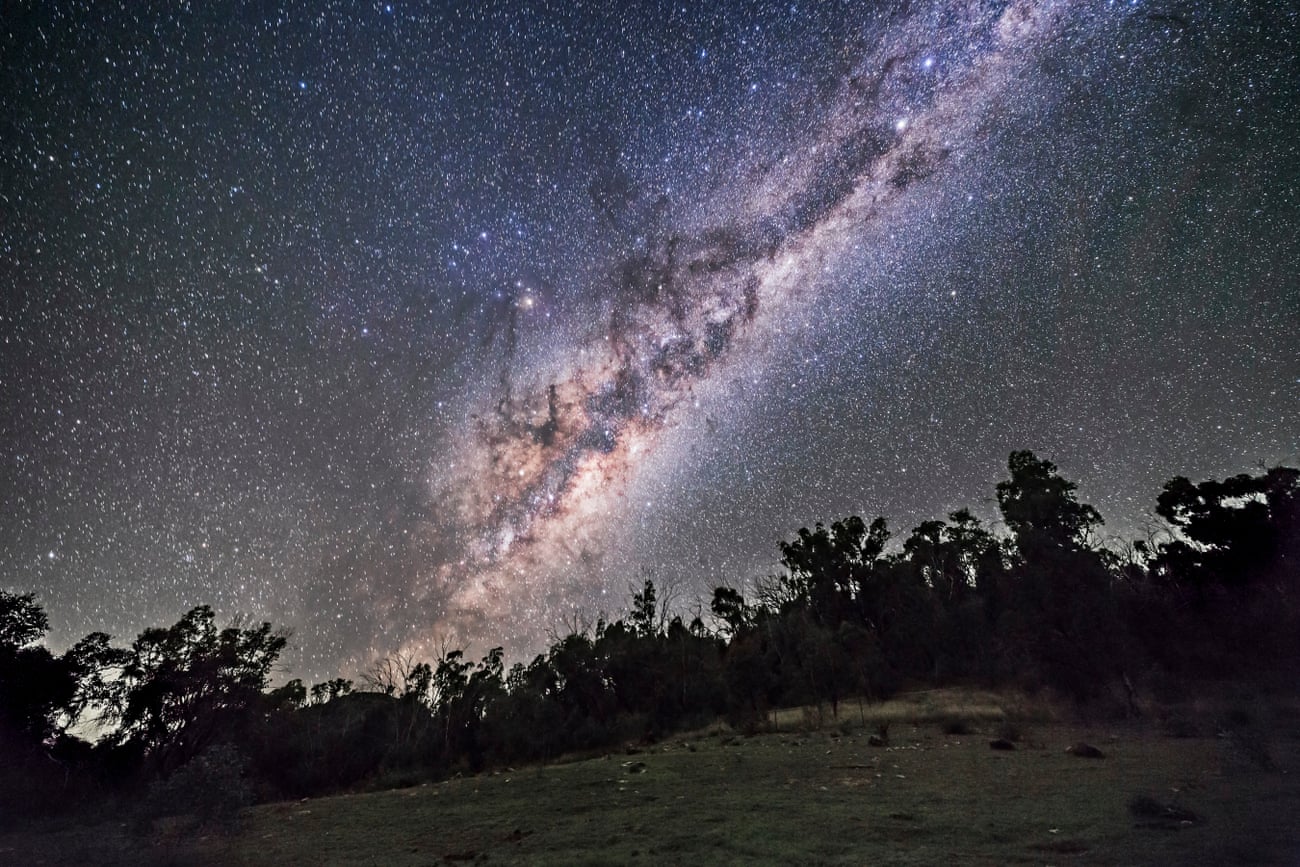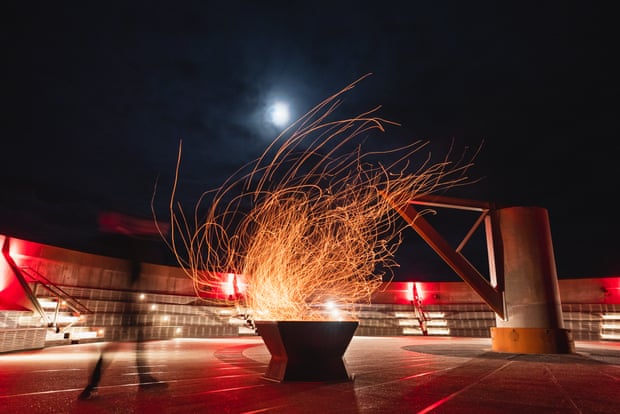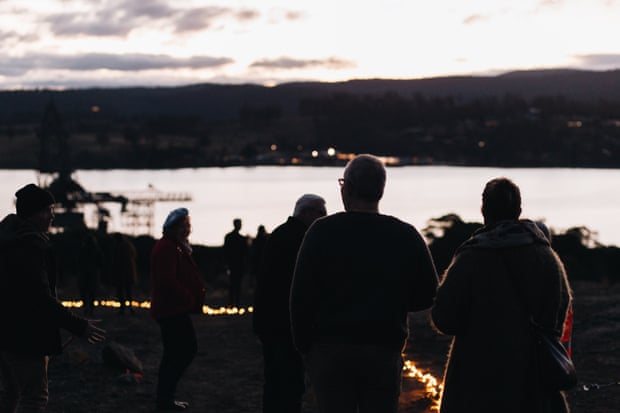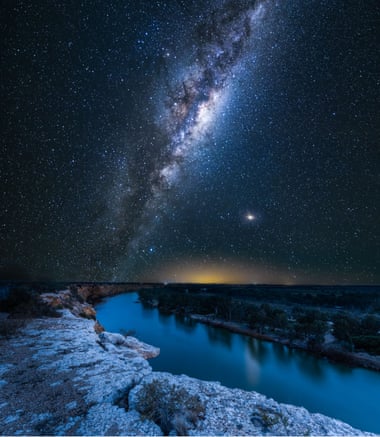Seeing stars: the astronomical rise of Australian dark-sky tourism | Australia holidays
An Aboriginal dreamtime story tells of the fire magic in the foot of Kambughuda, protecting her younger sisters from the hunter Nyeeruna.
The story doesn’t just exist in the oral tradition of the world’s oldest living cultures, it plays out in the night sky; the hunter Nyeeruna is known in the western astrological tradition as Orion; Kambughuda’s fire magic is the red star Aldebaran and her little sisters the Pleiades constellation.
Krystal De Napoli, a Gomeroi astrophysicist told us the story – which demonstrates Indigenous Australians knew of the variable stars around Orion long before European astronomers – at Nocturna, the dark sky party on Tasmania’s east coast, which concludes Hobart’s Beaker Street science and art festival.
The constellations “are our books”, De Napoli says. But this library is being hidden by light pollution.
Over 80% of the world’s population now live in areas where they cannot see stars. Beyond depriving humans of starlight, light pollution threatens the creatures of the night; bats, bogong moths, turtles and fireflies are all affected.
But at the same time as “sky glow” increasingly obscures the stars, Australians and New Zealanders are seeking out darkness for stargazing in ever-greater numbers.
The Mackenzie region in New Zealand’s south island has seen a 300% increase in visitors since Aoraki/Mount Cook national park and the Mackenzie Basin was named an International Dark Sky Reserve in 2012.

President of Dark Skies Tasmania, Landon Bannister, says the rise of astro-tourism happened organically. He sees it as part of a broader shift toward reconnecting with nature.
“It’s really important to embrace darkness. One of the most beautiful things about stargazing is to just take the time to let your eyes dark adapt. We spend so much time under artificial light now.”
The desire to see stars benefits rural communities. Urban billboards, car parks and multi-story office buildings lit up throughout the night are some of the biggest sources of light pollution.
Bannister says you have to drive around three hours from cities like Melbourne and Sydney to see the Milky Way – and even further from cities in the US and Europe. But in places like New Zealand and Tasmania, you only need to drive 30 minutes out of town to see the drifts of light that give the Milky Way its name.

Bannister says astro-tourism is not only low impact, it is actually key to protecting the dark skies. “It creates awareness and through awareness … people start to appreciate what they have. And that’s when people start to take action on protecting what they have.” He points to Mackenzie’s success and says that now other areas of New Zealand are seeking dark sky accreditation, in the hopes of replicating the region’s popularity.
“It really is the easiest pollutant of all to solve,” Bannister says. Unlike water and air pollution, light pollution does not take decades to reverse. “The stars are still there … it literally is a matter of just flicking a switch.”
While some light is essential for human safety, the worst effects of light pollution can be mitigated by keeping artificial light low and warm. At Nocturna, a dark-sky friendly snake of yellow lighting ran along the ground, guiding visitors between areas. Timers that switch off unneeded light help too.
The very low lighting does require some adjustment and cautious footwork, but events like Nocturna, and year-round Dark Sky places demonstrate it is possible to get by at night with far less light. In doing so, we open ourselves to other possibilities.

Thanks to Nocturna’s dimmed lights, Alpha Centauri was visible, even through cloud cover. Peering into a Schmidt Cassegraine long-focal length telescope, I spot it: a little spec of the universe magnified in closer detail than I have seen before.
I pulled away from the lens, starstruck, but Matthew McDonnell of the Astronomical Society of Tasmania urged me to look again. Alpha Centauri is actually a double star, two stars gravitationally bound to, and orbiting, each other. Sure enough there was a second circle poised directly behind the first.
McDonnell says double and triple stars are actually the norm in space – making up 80% of stars – but you need a telescope of this strength to reveal the split.
No matter whether looking through a telescope or the naked eye, the talk at Nocturna consistently came back to the awe the night sky can stir in us.

“We’ve always had the stars there to help us dream of bigger things and excite our imagination, but also to just remind us how small we are in the universe,” Bannister says. “Really, it’s a deeply human experience.”
Where to see stars
Australia is home to three official “dark sky places” as designated by the International Dark Sky Association (ISDA) whose accreditation includes categories such as parks, reserves and sanctuaries. These are the dark sky equivalent of a world heritage listing, but there is plenty of great stargazing to be enjoyed outside the officially listed zones too.
To see the sky put on a show, time your visit with a meteor shower. In 2022, the Orionids will peak from 21-22 October; the Leonids will peak from 17-18 November and the Geminids will peak from 14-15 December.

Warrumbungle Dark Sky Park (New South Wales)
-
The Warrumbungles calls itself the “astronomy capital of Australia”. It became the nation’s first ISDA Dark Sky Park in 2016 and is home to the country’s premier astronomical observatory.
-
During the day, the national park offers great hiking around its rocky, volcanic mountain landscape. At night, the sky is like a jewel box thanks to strict measures to protect against light pollution.
-
Located approximately six hour’s drive north-west of Sydney, those coming from the east can break up the trip with a stop in the wine and food hub of Mudgee. For accommodation, you can camp in the national park (though you will need to book several months in advance) or stay in Coonabarabran, a 30-minute drive away. Many of the holiday homes in the area come equipped with telescopes.
River Murray Dark Sky Reserve (South Australia)
-
The reserve, which received accreditation from ISDA in 2019, includes 80km of the Murray River, small townships, and conservation parks.
-
Adelaide is only 90 minutes away, but the Mount Lofty Ranges create a natural barrier, shielding the reserve from urban lighting.
-
In addition to stargazing, there are water activities like canoeing, fishing, and cruises along the Murray.
The Jump-Up (Queensland)

-
Named an ISDA dark sky sanctuary in 2019, the Jump-Up is approximately 270m above sea level and and sits atop a mesa plateau called the Vindex Range, from which stargazers can appreciate the breadth of the galaxy.
-
The Jump-Up is part of the Australian Age of Dinosaurs Museum, home to the largest collection of Australian dinosaur fossils in the world. The museum has a star gallery viewing area that is free and open year-round.
-
The site is on the outskirts of the outback town of Winton, 600km south-west of Townsville.
Bindoon (Western Australia)
-
This town, less than an hour’s drive from Perth has a special place in the history of space travel. It was home to the Muchea Tracking Station, which communicated with astronauts in orbit during the early 1960s.
-
You can catch the reflection of the stars in the water at Spoonbill Lake, or set up your own telescope at Brockman Centre, which is a designated observation area.
-
If you don’t own a telescope, head to the nearby town of Gingin where the Gravity Discovery centre and observatory offers regular night-time visits.
East Point Reserve (Northern Territory)
-
Just a couple of kilometres outside Darwin’s city centre, the reserve is known for its safe year-round saltwater swimming at Lake Alexander, and also offers great views of the stars at night.
-
If you want to venture further on your stargazing adventures in the Northern Territory, Uluru, Alice Springs, Tennant Creek and Katherine all offer near-pristine skies.
Snake Valley (Victoria)
-
Less than two hours from Melbourne, Snake Valley is an official Australian Dark Sky Site, located between Ballarat and Beaufort in the state’s…
Read More: Seeing stars: the astronomical rise of Australian dark-sky tourism | Australia holidays

